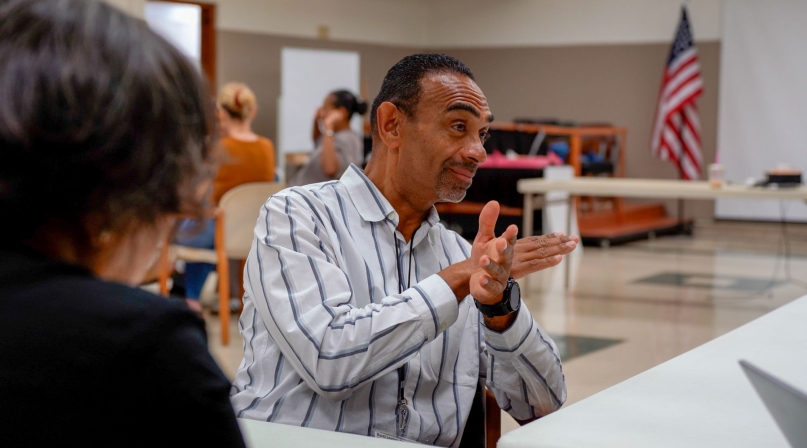Inland port offers opportunity for Hertford County, N.C.
Author
Upcoming Events
Related News

Key Takeaways
Hertford County, N.C. doesn’t have a lighthouse, but that hasn’t stopped its economic future from shining thanks to what became known as Project Green Lantern.
This rural county of less than 20,000 residents and its state partners are celebrating a big win for residents across the state, with hopes of new prosperity for the county and its residents.
Over the past six months, the county worked with leadership in the state Legislature, the state department of commerce, neighboring counties, area educational institutions and local industry to secure $51 million in state funding to build a new inland port, including a county-owned and county-operated barge transportation system, with an additional $6 million in infrastructure upgrades.
“I think the opportunities are unlimited,” said Commission Chair André Lassiter Sr. “I think this will spur economic growth that the region has never, ever seen. We’re going to be open to business from Nova Scotia to the Gulf of Mexico.”
During the 2010s, the county lost roughly 3,000 residents, due in no small part, Lassiter said, to limited economic opportunities. Now, this state funding will unlock significant industry investment for new manufacturing plants, employment opportunities and workforce training in high-demand jobs.
Lassiter and Economic Development Director Kelly Leggett Bowers explored applying a community benefit agreement approach to their negotiations with corporations considering opening new production facilities in the county after discussing the concept as part of NACo’s Rural Leaders for Economic Mobility program (RLEM).
This approach can lead to a binding agreement between the county and industry partners to both make meaningful contributions to county residents and to provide support for development projects.
Hertford County’s RLEM team recognized that the county has much to offer industry looking to locate near key customers and supply-chain networks. The county’s existing anchor institutions are clustered around manufacturing and steel production, including Nucor Steel and Structural Steel Coatings. The county is an hour from the Norfolk Naval Shipyard, which is a major end-user of manufactured goods.
Bowers leveraged these assets in piquing the interest of new companies considering a move to Hertford County.
“We painted a picture for our partners of a company that comes into Hertford County and manufactures steel parts for all industries across the United States, from nuclear, hydrogen, offshore wind, oil, aeronautics. automotive and shipbuilding,” she said.
Lassiter was excited by the prospect of adding new jobs and taxable entities to the county, but he wanted to be sure that current residents truly benefited from these new opportunities. He was skeptical of outmoded business attraction approaches that incentivized business by forgoing county revenue in property tax waivers or with little commitment to employing local residents. For example, in 2000, the state Legislature awarded a lifetime tax break to a corporation that allows for $2 billion in personal property to remain in the county untaxed.
“We wound up with a major industry in our county that had very little tax benefit,” he said. “We didn’t want that to happen twice. This time, when the topic of a tax break came up, we wanted to make sure we had the foundation for a good corporate partnership.”
Lassiter found those partners within Project Green Lantern. Together they developed a proposed community benefit agreement that pledged up to $24 million over 10 years to support education and workforce development initiatives, thereby ensuring job creation, training and workforce housing for the community.
In coordination with these private industry commitments, the county worked with state partners to secure funding to build essential port infrastructure needed to ship manufactured goods from both existing and new businesses to key markets. State legislators recognized the potential statewide benefits of the inland harbor, including business attraction to the state, new high-wage employment and regional economic growth in an economically distressed rural area.
The county also worked closely with local stakeholders to ensure transparency and community benefit. Bowers engaged with Roanoke Chowan Community College, Chowan University, the NC East Alliance and Eastern Carolina University to align industry workforce needs with training and education programming. Monthly county-led meetings provided space for coordination and collaboration with local community organizations, state officials and interested residents. These partnerships will support long-term sustainability of a thriving regional economy with both local and statewide benefits.
The county sits an hour away from the port city of Norfolk, Va., “but they don’t have anywhere to build out industrial capacity,” Lassiter said. “One of our greatest assets is that we have land at a good price.
“I think we have positioned ourselves for a future that’s limitless and I’m excited for the opportunity. I think this would mitigate our outward migration situation,” Lassiter said. “Our brain trust has left because there were no job opportunities — I think we will see an influx of those young people and families coming back to the community because people don’t want to travel an hour-plus to work when these industries are built out.”
Related News

Counties and Railroads: Shared Priorities for the Next Surface Transportation Bill
County leaders from across the country have a vital opportunity to ensure their infrastructure priorities are front and center.

House reintroduces bipartisan legislation to level playing field for rural communities
House reintroduced the Rural Partnership and Prosperity Act, bipartisan legislation intended to advance economic development in rural counties and overcome barriers to obtaining federal funding and resources.

Podcast: Eastern Tennessee counties invest in tourism during shutdown
Sevier County, Tenn. refused to let the government shutdown devastate its fall tourism draw—Great Smoky Mountains National Park. County Mayor Larry Waters describes the lengths he and his neighbors went to keep the park open. And NACo Chief Government Affairs Officer Mark Ritacco offers an outlook on what counties can take away from the shutdown and into the future.
Featured Initiative
Rural Leaders for Economic Mobility
Rural Leaders for Economic Mobility is a knowledge-sharing peer learning network that will empower local government leaders and partners from 10 low-population counties.

